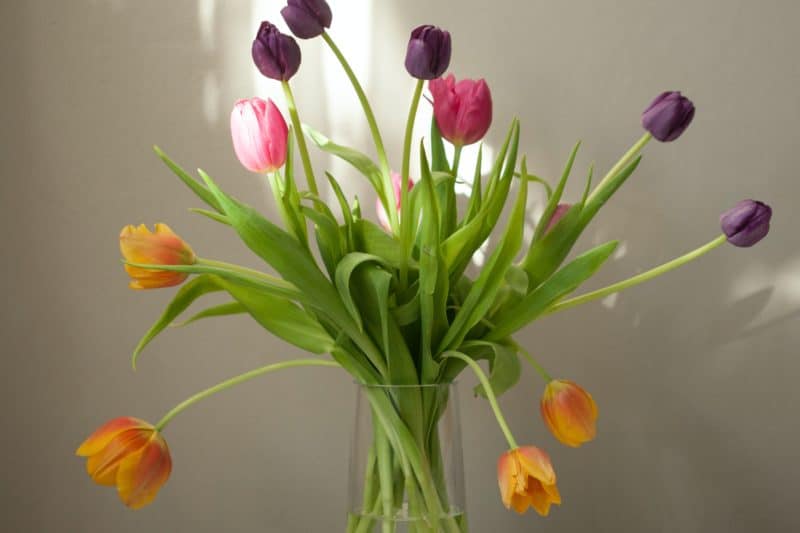Before becoming associated with The Netherlands, tulips were aplenty in the mountainous terrain of Central Asia. They could thrive in places located along the 40th parallel north, namely Turkey. It was here that European merchants learned about them and decided to grow some back home.

There’s no doubt that tulips grow best where springs are cool. With an average annual temperature of 48oF, The Netherlands is undeniably Tulip Country, with rows upon rows of colourful tulips and other flowers dotting the landscape. It’s no wonder it’s the largest exporter of flowers.
But once cut tulips reach other parts of the world, they won’t necessarily have access to their ideal growing conditions. You’ll have to make every effort to provide tulips with a conducive environment, from the vase of choice to the routine of replacing their water. Get it right, and your tulips can last up to roughly two weeks, at best. Read this step-by-step guide on basic tulip bouquet care.
Meanwhile, here are other ways to take care of these flowers:
1. Cut Stems at an Angle
Your priority is to get them into a vase partly filled with water upon receiving your cut tulips. To maximize their absorption, however, cut the stems at an angle, preferably 45 degrees.
As to why they have to be at an angle, think of the stem as a straw. If it has a flat bottom, it’ll have a hard time absorbing liquid since it’s kissing the base and blocking any flow. By cutting the stem at an angle, you can allow a better flow. It will also prevent pooling, which can quickly become a haven for harmful bacteria and fungi.
Use a well-honed knife or pair of scissors for the job, as dull edges may crush the stem and prevent uptake. You may also want to do this while rinsing the stems to keep the tulips hydrated.
2. Standing or Drooping?

The ideal vase for cut tulips depends on how you want them to appear. Do you want them to stand tall and proud? Or do you prefer them slumping?
Many people like to see their tulips stand upright, proudly showing their vivid blooms. In this case, choose a tall vase with a small neck to help keep the flowers steady. According to Leonard Perry, a professor at the University of Vermont Extension, a good rule of thumb for determining the right vase height is that it should be as tall or one-and-a-half times taller than the tulips.
For drooping tulips, you can opt for a flower vase with a wide neck. However, Perry suggests using a florist’s frog for this arrangement. By running the stems through its holes, a florist’s frog can aid in preventing the tulips from drooping too much. Floral foam can be an alternative, except if you deeply care for the environment.
3. Careful When Sharing
You may be tempted to place tulips in the same vase as your other flowers, which isn’t necessarily a bad thing. Forget-me-nots, bluebells, and wallflowers are among dozens of flowers that go well. But of course, some should never share the same space as your tulips.
Daffodils are one example, known to cause other cut flowers to wither and die too soon. An article by Compound Interest goes over this in detail, but the gist is that daffodils produce toxic chemicals that prevent water uptake in specific flowers. If you’ve cut daffodils before and noticed a viscous fluid in the water, that’s the culprit right there.
Understanding this fact is important if you want to make lovely floral arrangements for your home. You don’t like white tulips to lose their radiance because other flowers are competing for nutrients.
4. Avoid Direct Sunlight

As much as an image of a field of tulips under sunny skies impresses you, cut tulips actually don’t like basking under the sun for too long. Six to eight hours of direct sunlight is ideal but only during the morning when it’s not too hot yet.
Speaking of heat, they should also avoid hot areas like near the vents or the kitchen. Tulips flourish in the coldness of the mountains, if not The Netherlands’s low average yearly temperature, so heat is a big no-no. It doesn’t mean you have to crank up the air conditioner to replicate such conditions; the coolest part of your home will suffice.
Also, cut tulips are still photosensitive, meaning they’ll lean towards sunlight. You can keep their arrangement intact by turning the vase now and then.
Conclusion
Cut tulips require a higher degree of care now that they’re far from home. With proper care, they’ll stay just as vibrant as they first bloomed for as long as possible.


